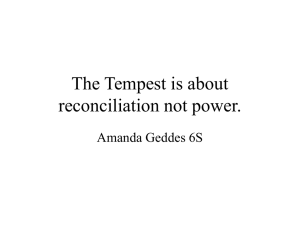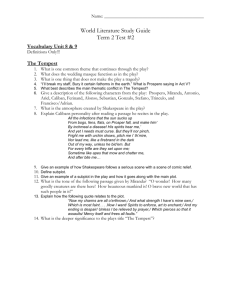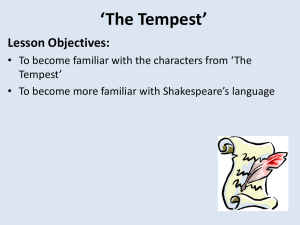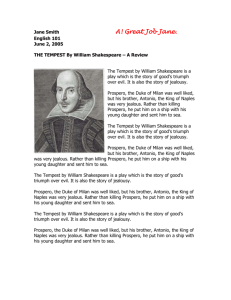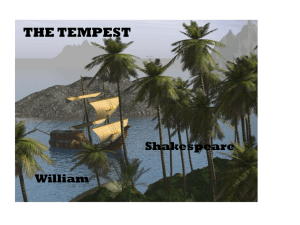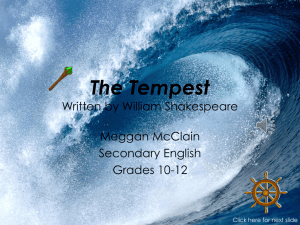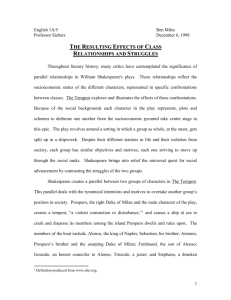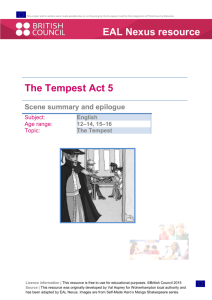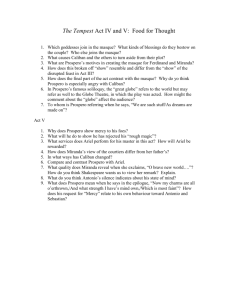Tempest Powerpoint
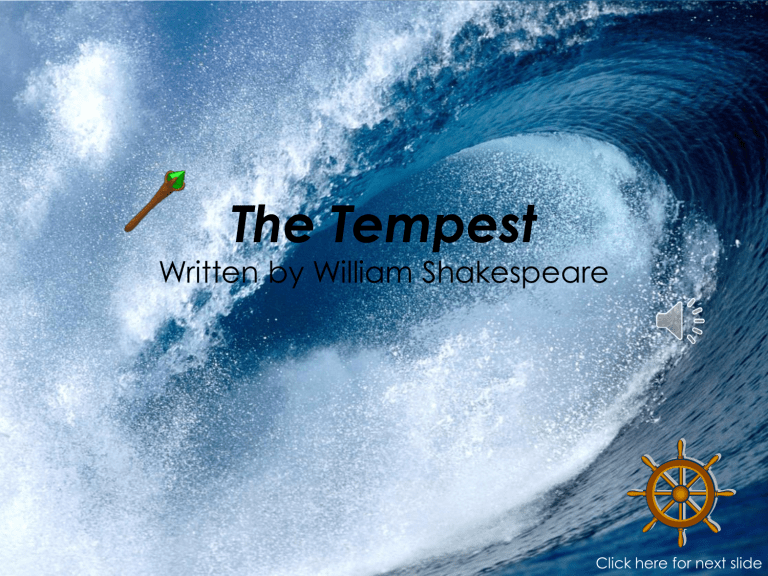
The Tempest
Written by William Shakespeare
Click here for next slide
William Shakespeare’s
The Tempest
• Generally regarded as Shakespeare’s last play: 1611
• Performed for King
James I and at the marriage festivities of his daughter Elizabeth
• Source: William
Strachey’s account of the shipwreck of the
Sea Venture in 1609
Paul Falconer Poole. A Scene from the
Tempest, 1856.
Themes
• Rulers and subjects
– Right relationship
– Responsibilities
– Master/Servant
• Revenge or mercy
– Sibling rivalry
• Commentary on
European exploration of new lands
– Utopianism
– Colonialism
– Imperialism
• “The Other”
– Nature of indigenous peoples
• The role of the artist
– Autobiographical?
Prospero by Lisa Iris
John William Waterhouse,
Miranda-The Tempest, c. 1916
“If by your art, my dearest father, you have put the wild waters in this roar, allay them”
Prospero usurper
Antonio
King of Naples
Alonso Sebastian Duke of Milan
Miranda
Sycorax Ariel
Iris
Ceres
Juno
Caliban Nymphs
Ferdinand
Gonzalo, Counselor
Trinculo, Jester
Stephano, Butler
Adrian, Francisco
Shipmaster, Boatswain, etc .
The Tempest
Main Menu
Click on each category to view detailed explanation:
Click Here To Begin Your Quiz!
Characters
• Prospero: The protagonist, the overthrown Duke of Milan who is now a sorcerer on a deserted island.
• Miranda: Daughter of Prospero.
• Ariel: A mischievous spirit who does
Prospero’s bidding and is visible only to him.
• Alonso: King of Naples.
• Sebastian: Alonso’s brother, who is attempting to kill his brother and nephew to steal the throne.
• Antonio: Prospero’s brother, new Duke of Milan, who sent Prospero to the island.
• Ferdinand: Alonso’s son, next in line for the throne.
Back to Main Menu
The Tempest: Concepts in Acts I and II
In The Tempest, Shakespeare seems to have anticipated the race, class and gender politics of Colonialism:
• Prospero is the Colonial Master, deposed from his European seat, and now imposing his rule on Caliban’s island
• Ariel is the “good native,” who happily does the bidding of the master
• Caliban is the “bad native” who must be controlled and enslaved
• Miranda is the “prize” the ideal of feminine purity that must be protected from the savages
• Ferdinand is the “heir” to Europe’s wealth and power, though he hasn’t done anything to deserve his good fortune
• Stephano and Trinculo represent the lower-class Europeans who emulate the upper class in seeking to take advantage of the natives
• Antonio, Adrian and Sebastian are European courtiers who will take advantage of any opportunity to advance their positions; Antonio
(brother of Prospero and usurping Duke of Milan) plots with Sebastian to overthrow his brother, Alonso (King of Naples)
Dramatic Structure
• Exposition: The beginning of the story which gives information that is necessary for the reader’s full understanding.
• Rising Action: Any action or actions that lead up to the climax of the story.
• Climax: The moment of pure conflict in the story, something huge is changing or happening to the
Protagonist.
• Falling Action: All conflict is being settled, things are slowly falling back into place.
• Denouement: The story is finished, and the audience is usually left with a sense of finality.
Back to Main Menu
Exposition
• Prospero, the rightful
Duke of Milan has just been overthrown and banished to an abandoned island by his own brother,
Antonio, who has allied himself with Milan’s enemy, Naples.
Back to Main Menu
Rising Action
• Prospero uses his sorcery and his spirit, Ariel, to create a storm which wrecks the ship which carries Antonio (his brother), Alonso (King of
Naples), Sebastian
(Alonso’s brother), and
Ferdinand (Alonso’s son), causing them to all be cast on to the island.
Back to Main Menu
Climax
• Miranda (Prospero’s daughter) and
Ferdinand (Alonso’s son) fall in love,
Prospero creates a series of magical interventions which cause Alonso to regret his past actions.
Back to Main Menu
Falling Action
• Antonio and
Sebastian’s plan to overthrow
Alonso is revealed.
Back to Main Menu
Denouement
• Prospero’s dukedom is restored, Antonio and Sebastian are forgiven, and the betrothal between
Miranda and
Ferdinand ensures peace between
Milan and Naples.
Back to Main Menu
Themes
• Revenge: Throughout the entire play, Prospero puts all of his energy into getting revenge on his brother.
• Jealousy: Jealousy plays a huge role in the story. There is jealousy between Prospero and Antonio and Alonso and Sebastian.
• Forgiveness: Forgiveness is the theme most commonly associated with Shakespeare’s
The Tempest. In the end of the play, everyone is forgiven, and all is well.
Back to Main Menu
Question 1: On the Dramatic
Structure diagram, where does the
Denouement fall?
Question 2: What is the name of
Prospero’s daughter?
Question 3: Why did Prospero send out the storm to wreck the ship and bring its habitants onto his island?
A. To get revenge on his brother
Question 4: In the end, who does
Miranda fall in love with?
Question 5: Which theme can most easily be tied to the play?
The End!
• Congratulations! You have finished today’s lesson on William
Shakespeare’s The Tempest.
• If you have any questions, comments, or concerns, don’t hesitate to contact me.
•
to return to the beginning of the lesson for the next student!
Great Job!
• Click here to move on to Question 2!
Nice Answer!
• Click here to move on to Question 3!
Fantastic!
• Click here to move on to Question 4!
Correct!
• Click here to move on to Question 5!
Sorry, try again!
• That is not quite where the
Denouement is on the Dramatic
Structure.
• Click here to go back to Question 1.
Sorry, try again!
• This character is not featured in The
Tempest, but rather in Shakepeare’s
Romeo and Juliet.
• Click here to go back to Question 2.
Sorry, try again!
• This character is not featured in The
Tempest, but rather in Shakespeare’s
Much Ado About Nothing.
• Click here to go back to Question 2.
Sorry, try again!
• Ariel is actually the spirit who does all of Prospero’s evil biddings.
• Click here to go back to Question 2.
Sorry, try again!
• That is not the reason Prospero wrecked his brother’s ship.
• Click here to go back to Question 3.
Sorry, try again!
• Alonso is the King of Naples, not the man who Miranda falls in love with.
• Click here to go back to Question 4.
Sorry, try again!
• Antonio is Prospero’s brother, therefore
Miranda’s uncle. He is not the man that Miranda falls in love with.
• Click here to go back to Question 4.
Sorry, try again!
• Romeo is actually a character not featured in The Tempest but in
Shakespeare’s Romeo and Juliet.
• Click here to go back to Question 4.
Sorry, try again!
• That is not the theme that is most closely tied with the play.
